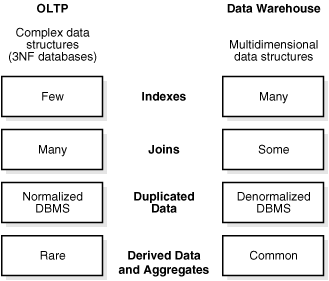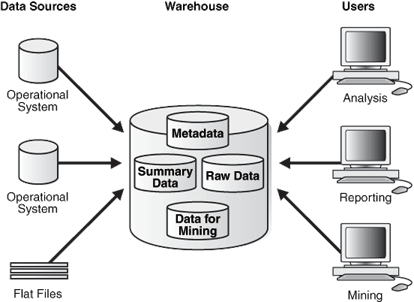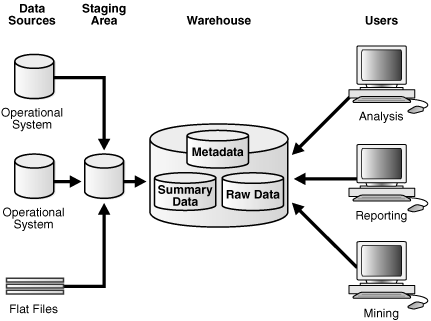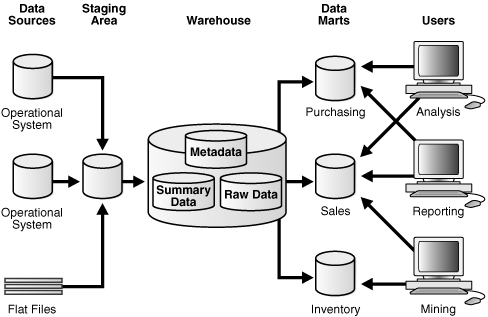| Oracle® Database Data Warehousing Guide 11g Release 1 (11.1) Part Number B28313-01 |
|
|
View PDF |
| Oracle® Database Data Warehousing Guide 11g Release 1 (11.1) Part Number B28313-01 |
|
|
View PDF |
This chapter provides an overview of the Oracle data warehousing implementation. It includes:
Extracting Information from a Data Warehouse
Note that this book is meant as a supplement to standard texts about data warehousing. This book focuses on Oracle-specific material and does not reproduce in detail material of a general nature. Two standard texts are:
The Data Warehouse Toolkit by Ralph Kimball (John Wiley and Sons, 1996)
Building the Data Warehouse by William Inmon (John Wiley and Sons, 1996)
A data warehouse is a relational database that is designed for query and analysis rather than for transaction processing. It usually contains historical data derived from transaction data, but can include data from other sources. Data warehouses separate analysis workload from transaction workload and enable an organization to consolidate data from several sources. This helps in:
Maintaining historical records
Analyzing the data to gain a better understanding of the business and to improve the business.
In addition to a relational database, a data warehouse environment can include an extraction, transportation, transformation, and loading (ETL) solution, statistical analysis, reporting, data mining capabilities, client analysis tools, and other applications that manage the process of gathering data, transforming it into useful, actionable information, and delivering it to business users.
A common way of introducing data warehousing is to refer to the characteristics of a data warehouse as set forth by William Inmon:
Data warehouses are designed to help you analyze data. For example, to learn more about your company's sales data, you can build a data warehouse that concentrates on sales. Using this data warehouse, you can answer questions such as "Who was our best customer for this item last year?" or "Who is likely to be our best customer next year?" This ability to define a data warehouse by subject matter, sales in this case, makes the data warehouse subject oriented.
Integration is closely related to subject orientation. Data warehouses must put data from disparate sources into a consistent format. They must resolve such problems as naming conflicts and inconsistencies among units of measure. When they achieve this, they are said to be integrated.
Nonvolatile means that, once entered into the data warehouse, data should not change. This is logical because the purpose of a data warehouse is to enable you to analyze what has occurred.
A data warehouse's focus on change over time is what is meant by the term time variant. In order to discover trends and identify hidden patterns and relationships in business, analysts need large amounts of data. This is very much in contrast to online transaction processing (OLTP) systems, where performance requirements demand that historical data be moved to an archive.
Figure 1-1 illustrates key differences between an OLTP system and a data warehouse.
Figure 1-1 Contrasting OLTP and Data Warehousing Environments

One major difference between the types of system is that data warehouses are not usually in third normal form (3NF), a type of data normalization common in OLTP environments.
Data warehouses and OLTP systems have very different requirements. Here are some examples of differences between typical data warehouses and OLTP systems:
Workload
Data warehouses are designed to accommodate ad hoc queries and data analysis. You might not know the workload of your data warehouse in advance, so a data warehouse should be optimized to perform well for a wide variety of possible query and analytical operations.
OLTP systems support only predefined operations. Your applications might be specifically tuned or designed to support only these operations.
Data modifications
A data warehouse is updated on a regular basis by the ETL process (run nightly or weekly) using bulk data modification techniques. The end users of a data warehouse do not directly update the data warehouse except when using analytical tools, such as data mining, to make predictions with associated probabilities, assign customers to market segments, and develop customer profiles.
In OLTP systems, end users routinely issue individual data modification statements to the database. The OLTP database is always up to date, and reflects the current state of each business transaction.
Schema design
Data warehouses often use denormalized or partially denormalized schemas (such as a star schema) to optimize query and analytical performance.
OLTP systems often use fully normalized schemas to optimize update/insert/delete performance, and to guarantee data consistency.
Typical operations
A typical data warehouse query scans thousands or millions of rows. For example, "Find the total sales for all customers last month."
A typical OLTP operation accesses only a handful of records. For example, "Retrieve the current order for this customer."
Historical data
Data warehouses usually store many months or years of data. This is to support historical analysis and reporting.
OLTP systems usually store data from only a few weeks or months. The OLTP system stores only historical data as needed to successfully meet the requirements of the current transaction.
Data warehouses and their architectures vary depending upon the specifics of an organization's situation. Three common architectures are:
Figure 1-2 shows a simple architecture for a data warehouse. End users directly access data derived from several source systems through the data warehouse.
Figure 1-2 Architecture of a Data Warehouse

In Figure 1-2, the metadata and raw data of a traditional OLTP system is present, as is an additional type of data, summary data. Summaries are very valuable in data warehouses because they pre-compute long operations in advance. For example, a typical data warehouse query is to retrieve something such as August sales. A summary in an Oracle database is called a materialized view.
You need to clean and process your operational data before putting it into the warehouse, as shown in Figure 1-2. You can do this programmatically, although most data warehouses use a staging area instead. A staging area simplifies building summaries and general warehouse management. Figure 1-3 illustrates this typical architecture.
Figure 1-3 Architecture of a Data Warehouse with a Staging Area

Although the architecture in Figure 1-3 is quite common, you may want to customize your warehouse's architecture for different groups within your organization. You can do this by adding data marts, which are systems designed for a particular line of business. Figure 1-4 illustrates an example where purchasing, sales, and inventories are separated. In this example, a financial analyst might want to analyze historical data for purchases and sales or mine historical data to make predictions about customer behavior.
Figure 1-4 Architecture of a Data Warehouse with a Staging Area and Data Marts

Note:
Data marts are an important part of many data warehouses, but they are not the focus of this book.You can extract information from the masses of data stored in a data warehouse by analyzing the data. The Oracle Database provides several ways to analyze data:
A wide array of statistical functions, including descriptive statistics, hypothesis testing, correlations analysis, test for distribution fit, cross tabs with Chi-square statistics, and analysis of variance (ANOVA); these functions are described in the Oracle Database SQL Language Reference.
OLAP
Data Mining
Data mining uses large quantities of data to create models. These models can provide insights that are revealing, significant, and valuable. For example, data mining can be used to:
Predict those customers likely to change service providers.
Discover the factors involved with a disease.
Identify fraudulent behavior.
Data mining is not restricted to solving business problems. For example, data mining can be used in the life sciences to discover gene and protein targets and to identify leads for new drugs.
Oracle Data Mining performs data mining in the Oracle Database. Oracle Data Mining does not require data movement between the database and an external mining server, thereby eliminating redundancy, improving efficient data storage and processing, ensuring that up-to-date data is used, and maintaining data security.
For detailed information about Oracle Data Mining, see Oracle Data Mining Concepts.
Oracle Data Mining supports the major data mining functions. There is at least one algorithm for each data mining function.
Oracle Data Mining supports the following data mining functions:
Classification: Grouping items into discrete classes and predicting which class an item belongs to; classification algorithms are Decision Tree, Naive Bayes, Generalized Linear Models (Binary Logistic Regression), and Support Vector Machines.
Regression: Approximating and predicting continuous numerical values; the algorithms for regression are Support Vector Machines and Generalized Linear Models (Multivariate Linear Regression).
Anomaly Detection: Detecting anomalous cases, such as fraud and intrusions; the algorithm for anomaly detection is one-class Support Vector Machines.
Attribute Importance: Identifying the attributes that have the strongest relationships with the target attribute (for example, customers likely to churn); the algorithm for attribute importance is Minimum Descriptor Length.
Clustering: Finding natural groupings in the data that are often used for identifying customer segments; the algorithms for clustering are k-Means and O-Cluster.
Associations: Analyzing "market baskets", items that are likely to be purchased together; the algorithm for associations is a priori.
Feature Extraction: Creating new attributes (features) as a combination of the original attributes; the algorithm for feature extraction is Non-Negative Matrix Factorization.
In addition to mining structured data, ODM permits mining of text data (such as police reports, customer comments, or physician's notes) or spatial data.
Oracle Data Mining APIs provide extensive support for building applications that automate the extraction and dissemination of data mining insights.
Data mining activities such as model building, testing, and scoring are accomplished through a PL/SQL API, a Java API, and SQL Data Mining functions. The Java API is compliant with the data mining standard JSR 73. The Java API and the PL/SQL API are fully interoperable.
Oracle Data Mining allows the creation of a supermodel, that is, a model that contains the instructions for its own data preparation. The embedded data preparation can be implemented automatically and/or manually. Embedded Data Preparation supports user-specified data transformations; Automatic Data Preparation supports algorithm-required data preparation, such as binning, normalization, and outlier treatment.
SQL Data Mining functions support the scoring of classification, regression, clustering, and feature extraction models. Within the context of standard SQL statements, pre-created models can be applied to new data and the results returned for further processing, just like any other SQL query.
Predictive Analytics automates the process of data mining. Without user intervention, Predictive Analytics routines manage data preparation, algorithm selection, model building, and model scoring so that the user can benefit from data mining without having to be a data mining expert.
ODM programmatic interfaces include
Data mining functions in Oracle SQL for high performance scoring of data
DBMS_DATA_MINING PL/SQL packages for model creation, description, analysis, and deployment
DBMS_DATA_MINING_TRANSFORM PL/SQL package for transformations required for data mining
Java interface based on the Java Data Mining standard for model creation, description, analysis, and deployment
DBMS_PREDICTIVE_ANALYTICS PL/SQL package supports the following procedures:
EXPLAIN - Ranks attributes in order of influence in explaining a target column
PREDICT - Predicts the value of a target column
PROFILE - Creates segments and rules that identify the records that have the same target value